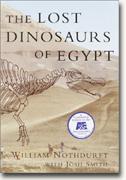The Lost Dinosaurs of Egypt
William Nothdruft with Josh Smith
book reviews:
· general fiction
· chick lit/romance
· sci-fi/fantasy
· graphic novels
· nonfiction
· audio books
· author interviews
· children's books @
curledupkids.com
· DVD reviews @
curledupdvd.com
newsletter
win books
buy online
links
home
for authors
& publishers
for reviewers

 |
The Lost Dinosaurs of Egypt William Nothdruft with Josh Smith Random House Hardcover 256 pages September 2002 |
|
Imagine that you had discovered dinosaur bones that the world had never seen before. You meticulously mapped their location, shipped the bones to your city’s most prominent museum, and continued to spend the next thirty years cataloguing your discovery. Then, one night, your life’s work is reduced to ash and rubble, all evidence of its existence destroyed. This is what happened to Ernst Stromer van Reichenbach. On August 25, 1944, the Munich Museum was obliterated in an Allied bombing raid. Stromer was a brilliant man; he knew his work was in danger, and he pushed to have his collection relocated. His foresight was interpreted as anti-Nazi sentiment, and he was threatened with being sent to a concentration camp; instead, his three sons were shipped off to the most perilous wartime positions. Only one survived, returning from a Siberian labour camp in 1950. Stromer died in 1952; some say his belief that his remaining son would one day come home kept him alive.
It is no wonder this book appeared on the small screen as an A&E Documentary, and perhaps one day an emotional A&E Biography on Ernst Stromer. The reader learns a lot about dinosaurs, but it is painless. Note to Fred Flintstone: cancel that brontosaurus burger! The brontosaurus does not exist; it was found to be identical to a previously discovered creature named Apatosaurus and in the scientific world, as in any cafeteria, first come, first served. I enjoyed this book more than I thought I would and that is because of Stromer’s story. Smith and his team of scientists name their discovery
|
|
|
|
 Click here to learn more about this month's sponsor! |
|
| fiction · sf/f · comic books · nonfiction · audio newsletter · free book contest · buy books online review index · links · · authors & publishers reviewers |
|
| site by ELBO Computing Resources, Inc. | |
 Neither bones nor maps remained from Stromer’s 1911 Egyptian expedition. Over fifty years later, Josh Smith and a team of scientists return to the Bahariya Depression in the hopes of finding The Lost Dinosaurs of Egypt. The book jacket blurb states that “If you liked Indiana Jones, you’ll adore this tale...” I did enjoy the movie, and I did enjoy this book. However, Stromer’s story is what struck a chord with me – think Indiana Jones meets Treasure of the Sierra Madre meets Titanic. An odd mix, but it works. What doesn't work is the team members' patter filled with “Dude” and “Dumbass”. It's like reading the script for Bill and Ted’s Excellent Egyptian Adventure. At times it does seem like a dark comedy, especially the team lesson on identifying the local wildlife like the death stalker scorpion so they can tell the hospital staff what type of anti-venom to use. Then they stumble upon the biggest dinosaur discovery since, well, Stromer.
Neither bones nor maps remained from Stromer’s 1911 Egyptian expedition. Over fifty years later, Josh Smith and a team of scientists return to the Bahariya Depression in the hopes of finding The Lost Dinosaurs of Egypt. The book jacket blurb states that “If you liked Indiana Jones, you’ll adore this tale...” I did enjoy the movie, and I did enjoy this book. However, Stromer’s story is what struck a chord with me – think Indiana Jones meets Treasure of the Sierra Madre meets Titanic. An odd mix, but it works. What doesn't work is the team members' patter filled with “Dude” and “Dumbass”. It's like reading the script for Bill and Ted’s Excellent Egyptian Adventure. At times it does seem like a dark comedy, especially the team lesson on identifying the local wildlife like the death stalker scorpion so they can tell the hospital staff what type of anti-venom to use. Then they stumble upon the biggest dinosaur discovery since, well, Stromer.